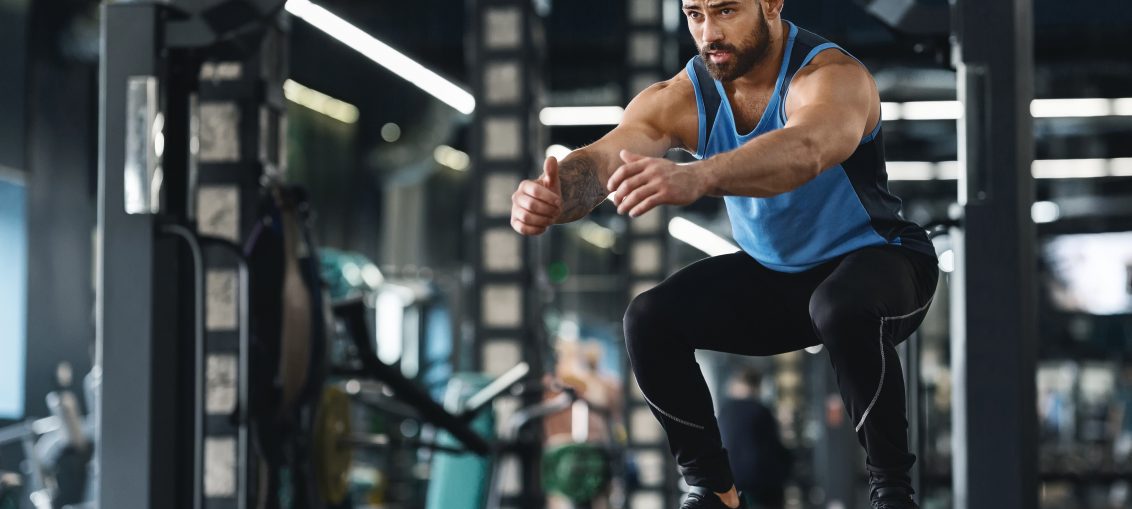
Rugby is a very physically demanding sport. It combines the stamina of soccer players with the strength and explosive power found in football athletes. This means that all 15 bodies on the pitch need to be finely tuned for every match despite what number is on the back of the jersey.
However, peak physical condition for each position is very specific. Here are the best exercises for all 15 rugby positions.
Jump to:
Hookers and Props
As a hooker or prop most of your fitness is going to come into play during a scrum. This will require a lot of pushing using the lower extremities but there will also be period of stagnant movement which will require strong isometric strength to withstand the resisting force of your opponents.
Anderson Squats
This exercise simulates lowering into position at the start of a scrum and exploding upward with force. This variation is much more difficult than a normal back squat, but it will help your muscles get used to exploding under a heavy load.
Walking Lunges
Similar to rucking, lunges require stabilization throughout the core and lower body and the walking variation will mimicking moving forward during a scrum or a maul.
Overhead Push Press
Strong shoulders are necessary both in the scrum and during lineouts. The push press variation allows for the legs to contribute force into the overhead press similar to the lifting portion of a lineout.
Locks
Like the front row players, locks are required to engage during scrums but one of your biggest responsibilities on the pitch as a 4 or 5 is to win lineouts which require a lot of explosive power and core stability to remain tight as your lifted.
Squat Jumps
Similar to a normal back squat but your focus shouldn’t be on getting to proper depth, instead focus on exploding upwards without letting the barbell lift off of your back. The goal is to mimic a typical lineout jump under a relatively light load, emphasis on the “light” as you don’t want to hurt your back or neck during this movement.
Box Jumps
You might recognize box jumps from a CrossFit WOD which is good because then you’re at least familiar with the exercise. However, whereas most functional fitness programs prescribe higher rep box jumps you are going to focus on height and quality over repetition. The goal is to increase your overall vertical height, not to get your heart-rate firing.
Planks
During a lineout it isn’t just your lifters who need to be strong, it’s you as well. You need to have a strong and stable core so that when you’re elevated you can reach and bend to secure the ball for your team safely and in a controlled manner. This requires a lot of core stabilization and there are many variations of the plank that can be used to progress this exercise as it becomes easier.
Flankers and 8 Man
As a flanker you have the difficult job of pushing from the back of the scrum then sprinting with the ball to gain some quick ground. The physical requirements for flankers are less focused on absolute strength and more aim more to increase explosive power that will translate to sprinting a few meters with the ball immediately following a scrum.
Power Cleans
One of the most effective exercises, the power clean combines strength, speed, and balance into one incredible movement. If you’re unfamiliar with the power clean, ask a coach or a teammate to teach you the proper mechanics to avoid injury in the lower back and wrists. Once you feel you’ve got the movement down opt for a combination of higher sets with lower reps to improve movement quality and simulate explosiveness off a scrum.
Heavy Sled Push
This exercise can and should be applied to all forwards as it is nearly identical to what you will see during a scrum. It also doesn’t require a whole lot of time learning the technique – you just push the sled and drive your legs forward, sound familiar? While you can do sled pushes with a relatively lighter weight over longer distances for conditioning, forwards will benefit more from a heavier sled over a short distance which emphasizes driving the legs against an opponent during a scrum, maul, or even a ruck.
Short Distance Sprints
Think 10-20 meters here. These sprints should be done at maximum effort with plenty of rest time in between rounds. Keep the number of sets high and the distance short to encourage maximum effort with each sprint. Be sure to do these wearing boots on the pitch to get your feet used to the traction you will feel during a match.
Scrum Half and Fly Half
As the “quarterback” of the pitch, halfbacks need to see everything that the defense is doing, spot openings, marshal the backs into position to expose those weaknesses, and ultimately, get the ball moving down the line. Besides being extremely mentally taxing, these positions require strong lateral movement and rotational strength in the core.
Sumo Deadlift
This is not your typical deadlift because it places more emphasis on the hamstrings and low back. As a halfback you will do a lot bending and stopping abruptly to get behind a scrum or a ruck which requires a strong posterior chain. Use around 80% of your 1RM to emphasize power throughout the lifting portion of the movement.
Medicine Ball Toss
Similar to heavy sled pushing for forwards, this exercise is the no-brainer for backs. You need to have rotational core strength and there isn’t a better exercise that incorporates trunk rotation with hand eye coordination than medicine ball toss variations. Volume, volume, volume! You’ll be passing A LOT during a match so learn to love these exercises.
Lateral Sprints
A good portion of conditioning programs place emphasis on forward and backward sprinting, but it’s hard to find a program that places an equal amount of time on lateral movement. As a halfback you will be moving side to side quite a bit and to avoid any painful groin or ankle injuries it is best to train horizontal movement with lateral shuffles and turn-to-sprint drills.
Centers
The bigger backs are short distance, heavy sprinters that can break the line in the blink of an eye and wrap up the opponent quickly before they gain any traction. This position requires almost all the qualities of the previously mentioned positions while incorporating a higher level of sprinting and stamina to maintain consistency throughout the match.
Power Cleans
One of the most effective exercises, the power clean combines strength, speed, and balance into one incredible movement. If you’re unfamiliar with the power clean, ask a coach or a teammate to teach you the proper mechanics to avoid injury in the lower back and wrists. Once you feel you’ve got the movement down opt for a combination of higher sets with lower reps to improve movement quality and simulate explosiveness off a scrum.
Lower Body Plyometrics
As a center your legs will be taxed in more ways than most other players on the pitch. You are required to be the hard-hitting attack man for short balls, but also expected to be able to provide support for wings and fullbacks down the pitch during breakaways. This means a lot of explosive and repeated movements through various planes like jumping squats, box jumps, jumping lunges, bounds, etc.
Short and Long-Distance Sprints
Vary the distances from anywhere between 10-60 meters. As a back you never know when you or your teammate could have a break away, so you need to be conditioned to accelerate quickly and have a sustained effort throughout the entire distance.
Wings and Fullbacks
As an outer perimeter player, you will be involved in rucks and tackles from time to time but your main concern is receiving the ball and making a break for the try zone as quickly as possible. Sometimes wings or fullbacks only pick up 10m during a run and other times you can run nearly the full length of the pitch following a deep kick or to score. The main focus of your training is around explosive movements and stamina.
Short and Long-Distance Sprints
Vary the distances from anywhere between 10-60 meters. As a back you never know when you or your teammate could have a break away, so you need to be conditioned to accelerate quickly and have a sustained effort throughout the entire distance.
Lower Body Plyometrics
Similar to centers, your legs will be taxed in more ways than one. To simulate this, incorporate a lot of explosive movements like jumping squats, box jumps, jumping lunges, bounds, etc. through various planes at high repetitions.
Medicine Ball Pass
Similar to heavy sled pushing for forwards, this exercise is the no-brainer for backs. You need to have rotational core strength and there isn’t a better exercise that incorporates trunk rotation with hand eye coordination than medicine ball toss variations. Volume, volume, volume! You’ll be passing A LOT during a match so learn to love these exercises.
Exercises Every Position Should Be Doing
Position specific strength and conditioning is very important to your overall performance at practice and in a match. But there’s one aspect of any great fitness program that transcends your responsibilities on the pitch: your warm-up.
Long are the days of static stretching and counting to ten or doing a few jumping jacks to prepare for a match or a training session. Warm-ups are absolutely critical for every player on the pitch to loosen muscles, prevent injury, and prime your body for what it’s about to endure.
Highly decorated Cal Poly strength and conditioning coach, Chris Holder, developed the perfect warm, appropriately titled the Cal Poly Hip Flow, that he implements with all his players regardless of position or sport.
Further Reading
In addition to these intense workouts, we also recommend you check these two books made specifically for rugby:
100 Rugby Conditioning Workouts For Beginners To Beasts

Ultimate Guide to Weight Training for Rugby

RugbyReader.com is reader-supported. If you buy via the links on our site, we may earn an affiliate commission at no cost to you
